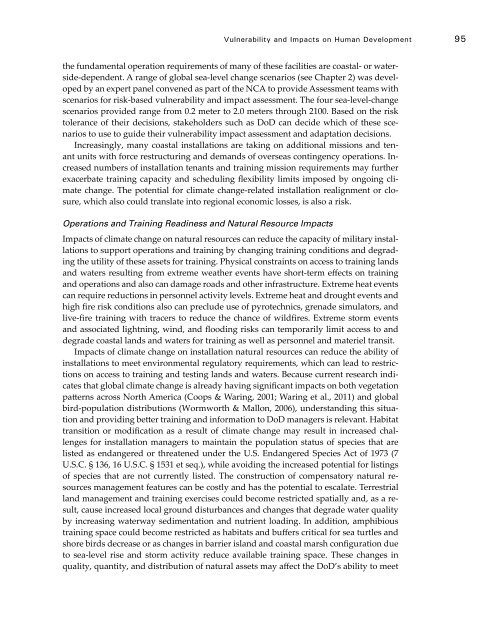Coastal Impacts, Adaptation, and Vulnerabilities - Climate ...
Coastal Impacts, Adaptation, and Vulnerabilities - Climate ...
Coastal Impacts, Adaptation, and Vulnerabilities - Climate ...
You also want an ePaper? Increase the reach of your titles
YUMPU automatically turns print PDFs into web optimized ePapers that Google loves.
Vulnerability <strong>and</strong> <strong>Impacts</strong> on Human Development 95the fundamental operation requirements of many of these facilities are coastal- or waterside-dependent.A range of global sea-level change scenarios (see Chapter 2) was developedby an expert panel convened as part of the NCA to provide Assessment teams withscenarios for risk-based vulnerability <strong>and</strong> impact assessment. The four sea-level-changescenarios provided range from 0.2 meter to 2.0 meters through 2100. Based on the risktolerance of their decisions, stakeholders such as DoD can decide which of these scenariosto use to guide their vulnerability impact assessment <strong>and</strong> adaptation decisions.Increasingly, many coastal installations are taking on additional missions <strong>and</strong> tenantunits with force restructuring <strong>and</strong> dem<strong>and</strong>s of overseas contingency operations. Increasednumbers of installation tenants <strong>and</strong> training mission requirements may furtherexacerbate training capacity <strong>and</strong> scheduling flexibility limits imposed by ongoing climatechange. The potential for climate change-related installation realignment or closure,which also could translate into regional economic losses, is also a risk.Operations <strong>and</strong> Training Readiness <strong>and</strong> Natural Resource <strong>Impacts</strong><strong>Impacts</strong> of climate change on natural resources can reduce the capacity of military installationsto support operations <strong>and</strong> training by changing training conditions <strong>and</strong> degradingthe utility of these assets for training. Physical constraints on access to training l<strong>and</strong>s<strong>and</strong> waters resulting from extreme weather events have short-term effects on training<strong>and</strong> operations <strong>and</strong> also can damage roads <strong>and</strong> other infrastructure. Extreme heat eventscan require reductions in personnel activity levels. Extreme heat <strong>and</strong> drought events <strong>and</strong>high fire risk conditions also can preclude use of pyrotechnics, grenade simulators, <strong>and</strong>live-fire training with tracers to reduce the chance of wildfires. Extreme storm events<strong>and</strong> associated lightning, wind, <strong>and</strong> flooding risks can temporarily limit access to <strong>and</strong>degrade coastal l<strong>and</strong>s <strong>and</strong> waters for training as well as personnel <strong>and</strong> materiel transit.<strong>Impacts</strong> of climate change on installation natural resources can reduce the ability ofinstallations to meet environmental regulatory requirements, which can lead to restrictionson access to training <strong>and</strong> testing l<strong>and</strong>s <strong>and</strong> waters. Because current research indicatesthat global climate change is already having significant impacts on both vegetationpatterns across North America (Coops & Waring, 2001; Waring et al., 2011) <strong>and</strong> globalbird-population distributions (Wormworth & Mallon, 2006), underst<strong>and</strong>ing this situation<strong>and</strong> providing better training <strong>and</strong> information to DoD managers is relevant. Habitattransition or modification as a result of climate change may result in increased challengesfor installation managers to maintain the population status of species that arelisted as endangered or threatened under the U.S. Endangered Species Act of 1973 (7U.S.C. § 136, 16 U.S.C. § 1531 et seq.), while avoiding the increased potential for listingsof species that are not currently listed. The construction of compensatory natural resourcesmanagement features can be costly <strong>and</strong> has the potential to escalate. Terrestriall<strong>and</strong> management <strong>and</strong> training exercises could become restricted spatially <strong>and</strong>, as a result,cause increased local ground disturbances <strong>and</strong> changes that degrade water qualityby increasing waterway sedimentation <strong>and</strong> nutrient loading. In addition, amphibioustraining space could become restricted as habitats <strong>and</strong> buffers critical for sea turtles <strong>and</strong>shore birds decrease or as changes in barrier isl<strong>and</strong> <strong>and</strong> coastal marsh configuration dueto sea-level rise <strong>and</strong> storm activity reduce available training space. These changes inquality, quantity, <strong>and</strong> distribution of natural assets may affect the DoD’s ability to meet
















